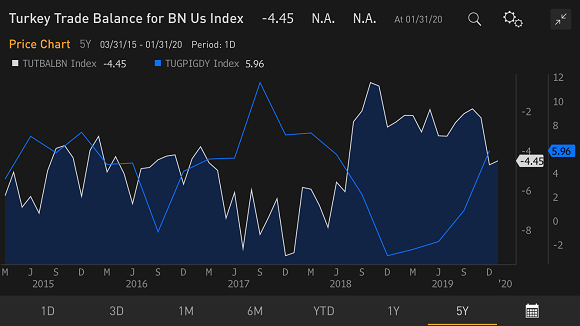By Natalia Gurushina, Economist, Emerging Markets Fixed Income for VanEck Global
Turkey’s above-consensus Q4 real GDP growth (6% year-on-year) attracted a lot of attention this morning. A very low base effect definitely helped to generate such a high number. However, sequential growth was also strong—propelled by credit expansion and interest rate cuts. The reliance on consumption and cheap loans from state banks raises a question mark about the quality and sustainability of expansion. Another side-effect to watch is the deteriorating trade balance and current account, both of which are inversely related to growth (see chart below).
China just passed another set of measures to support small and medium-sized enterprises (SMEs)—this time on the fiscal side. The government decided to temporarily reduce SMEs’ social security contributions—a welcome move given that this group faces higher funding costs and was heavily affected by the virus-related Lunar New Year closures and cancellations. The package is fairly sizable (around 0.6% of GDP) and it is expected to have a meaningful impact both on SMEs’ bottom lines and on their ability to maintain employment (hence, consumption)—at least in the near-term.
India’s growth weakened further in Q4, sliding to 4.7% year-on-year. It’s not just the growth trajectory that is deteriorating. The quality of growth looks sub-optimal as well—it is driven by government spending, while investments are moving further into contraction territory (-5.2% year-on-year in Q4). We are cognizant of major structural changes that are taking place in India and we think that many of them can improve the country’s longer-term growth outlook. However, the near-term growth revival might be tepid without additional policy support.
Chart at a Glance: Turkey Growth Rebounds, but Trade Balance Goes South

Source: Bloomberg LP
Note: Blue line is real GDP growth, white line is trade balance.
IMPORTANT DEFINITIONS & DISCLOSURES
PMI – Purchasing Managers’ Index: economic indicators derived from monthly surveys of private sector companies; ISM – Institute for Supply Management PMI: ISM releases an index based on more than 400 purchasing and supply managers surveys; both in the manufacturing and non-manufacturing industries; CPI – Consumer Price Index: an index of the variation in prices paid by typical consumers for retail goods and other items; PPI – Producer Price Index: a family of indexes that measures the average change in selling prices received by domestic producers of goods and services over time; PCE inflation – Personal Consumption Expenditures Price Index: one measure of U.S. inflation, tracking the change in prices of goods and services purchased by consumers throughout the economy; MSCI – Morgan Stanley Capital International: an American provider of equity, fixed income, hedge fund stock market indexes, and equity portfolio analysis tools; VIX – CBOE Volatility Index: an index created by the Chicago Board Options Exchange (CBOE), which shows the market’s expectation of 30-day volatility. It is constructed using the implied volatilities on S&P 500 index options.; GBI-EM – JP Morgan’s Government Bond Index – Emerging Markets: comprehensive emerging market debt benchmarks that track local currency bonds issued by Emerging market governments.; EMBI – JP Morgan’s Emerging Market Bond Index: JP Morgan’s index of dollar-denominated sovereign bonds issued by a selection of emerging market countries; EMBIG – JP Morgan’s Emerging Market Bond Index Global: tracks total returns for traded external debt instruments in emerging markets.
The information presented does not involve the rendering of personalized investment, financial, legal, or tax advice. This is not an offer to buy or sell, or a solicitation of any offer to buy or sell any of the securities mentioned herein. Certain statements contained herein may constitute projections, forecasts and other forward looking statements, which do not reflect actual results. Certain information may be provided by third-party sources and, although believed to be reliable, it has not been independently verified and its accuracy or completeness cannot be guaranteed. Any opinions, projections, forecasts, and forward-looking statements presented herein are valid as the date of this communication and are subject to change.
Investing in international markets carries risks such as currency fluctuation, regulatory risks, economic and political instability. Emerging markets involve heightened risks related to the same factors as well as increased volatility, lower trading volume, and less liquidity. Emerging markets can have greater custodial and operational risks, and less developed legal and accounting systems than developed markets.
All investing is subject to risk, including the possible loss of the money you invest. As with any investment strategy, there is no guarantee that investment objectives will be met and investors may lose money. Diversification does not ensure a profit or protect against a loss in a declining market. Past performance is no guarantee of future performance.







